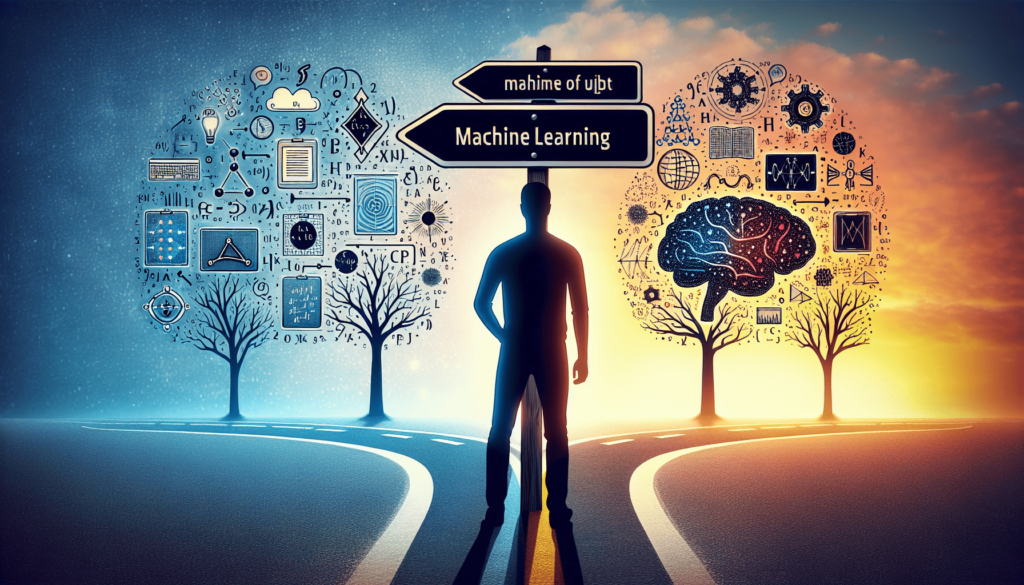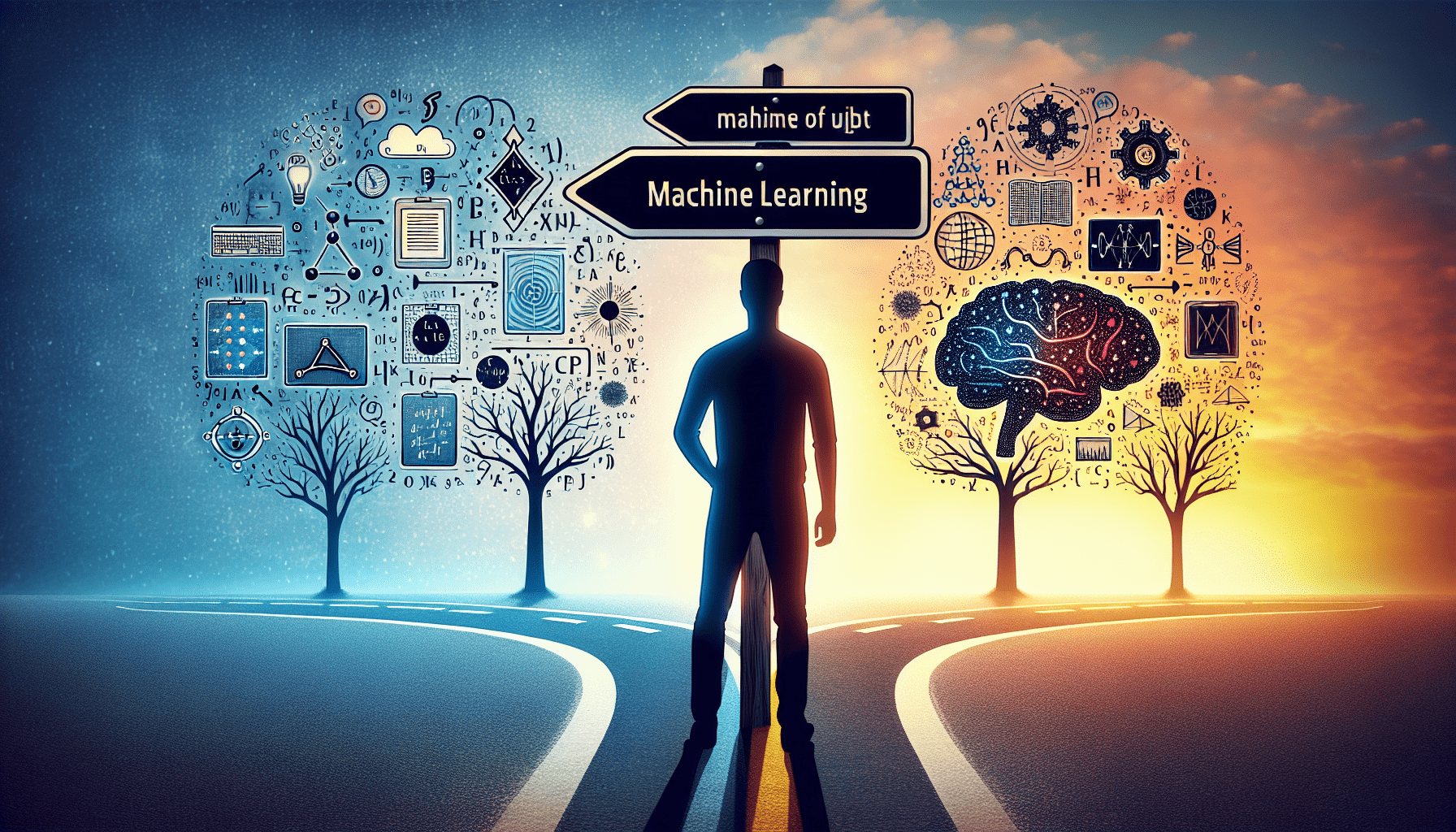So, you’ve been hearing a lot about AI and all the incredible things it can do, but you’re wondering if you need to learn machine learning (ML) before diving into the world of artificial intelligence (AI). Well, fear not my friend, because in this article we’re going to explore whether mastering ML is a prerequisite for understanding AI. You may be surprised to find out that the relationship between these two fields is not as straightforward as it seems. So, let’s embark on this journey together and uncover the truth about ML and AI!

Understanding the Relationship between Machine Learning (ML) and Artificial Intelligence (AI)
Definition of ML and AI
Machine Learning (ML) and Artificial Intelligence (AI) are terms that are often used interchangeably, but they have distinct meanings. AI refers to the broader concept of machines or computers performing tasks that would typically require human intelligence. It encompasses various techniques, including ML. ML, on the other hand, focuses on the development of algorithms that allow computers to learn from and make predictions or decisions based on data.
ML as a Subset of AI
While AI is a broader concept, ML can be considered a subset of AI. ML algorithms enable computers to learn and improve from experience or data without being explicitly programmed. These algorithms are a key component of AI systems, as they enable the system to make autonomous and adaptive decisions based on the data it has been trained on.
Interdependency of ML and AI
ML and AI are interdependent on each other. ML provides the necessary algorithms and techniques for building intelligent systems, while AI provides the overarching framework and context for ML algorithms. Without ML, AI systems would not be able to learn, adapt, and make intelligent decisions based on data. Similarly, ML algorithms derive their purpose and significance from their application in AI systems.
Building Blocks of AI
Data
Data is the foundation of AI. It serves as the fuel for ML algorithms and enables AI systems to learn and make intelligent decisions. High-quality and diverse data plays a crucial role in training ML models and ensuring accurate predictions and insights.
Algorithms
Algorithms are the mathematical models that power ML processes. They determine how machines learn from data, make predictions, and optimize their performance. Various types of ML algorithms, such as supervised learning, unsupervised learning, and reinforcement learning, enable different approaches to problem-solving and decision-making in AI systems.
Computing Power
AI systems require significant computing power to handle the large volumes of data and complex calculations involved in ML processes. Advances in hardware, such as GPUs (Graphics Processing Units), cloud computing, and parallel processing architectures, have greatly contributed to the capabilities of AI systems.
Domain Knowledge
Domain knowledge refers to the understanding of the specific field or industry in which AI systems are being applied. It is important to have domain knowledge to effectively utilize ML algorithms and interpret their outputs. Without domain knowledge, AI systems may produce inaccurate or irrelevant results.
Introduction to Machine Learning
Definition of ML
Machine Learning (ML) is a branch of AI that focuses on the development of algorithms and models that enable computers to learn from and make predictions or decisions based on data. ML algorithms can automatically improve their performance and accuracy by learning from new data without being explicitly programmed.
Types of ML Algorithms
There are various types of ML algorithms, each suited for different types of tasks and data. Supervised learning algorithms learn from labeled data to make predictions or classifications. Unsupervised learning algorithms identify patterns and relationships in unlabeled data. Reinforcement learning algorithms learn by interaction with an environment to optimize actions and rewards.
Role of ML in AI
ML plays a vital role in AI by enabling machines to learn from data, adapt to new information, and make autonomous decisions. ML algorithms form the core building blocks of AI systems, as they provide the capability to learn, analyze and process data, and make predictions or decisions based on that data.
Understanding Artificial Intelligence
Definition of AI
Artificial Intelligence (AI) refers to the field of study and development of machines or computer systems that can perform tasks that would typically require human intelligence. AI encompasses a broad range of techniques, including ML, computer vision, natural language processing, and robotics, among others.
Scope and Applications of AI
The scope of AI is vast and its applications are diverse. AI is used in various fields, including healthcare, finance, marketing, transportation, and security. AI techniques are applied to automate tasks, make predictions, optimize processes, and improve decision-making. AI systems can analyze and interpret vast amounts of data at a speed and accuracy far beyond human capability.

The Importance of Learning Machine Learning before AI
Foundation for AI Concepts
Learning ML before AI provides a solid foundation in understanding the fundamental concepts and principles of AI. ML introduces learners to the algorithms and techniques that enable machines to learn from data, which is a crucial aspect of AI. By learning ML first, individuals gain a strong grasp of the underlying mechanisms that power AI systems.
Understanding ML Algorithms
ML algorithms form the backbone of AI systems. By learning ML, individuals gain an in-depth understanding of various algorithms, their strengths, limitations, and applicability to different problems. This knowledge is valuable when designing, implementing, and optimizing AI solutions.
Data Preparation and Pre-processing
In ML, data preparation and pre-processing are essential steps to ensure the accuracy and reliability of ML models. By learning ML, individuals gain hands-on experience in data cleaning, feature selection, and data transformation techniques. These skills are crucial for effectively handling and preparing data for AI applications.
Feature Engineering
Feature engineering involves selecting and transforming raw input data to a format that ML algorithms can effectively utilize. By learning ML, individuals develop the skills to identify relevant features, extract meaningful information, and create new features that can enhance the performance of ML models. These skills are directly applicable to AI systems.
Model Selection and Evaluation
ML involves selecting the appropriate model based on the problem at hand and evaluating its performance. By learning ML, individuals acquire the knowledge and expertise to choose the most suitable ML model for different tasks. This understanding is vital in AI applications where model selection and evaluation are critical for achieving optimal results.
Benefits of Learning ML before AI
Ability to Leverage Existing ML Models
One of the benefits of learning ML before AI is the ability to leverage existing ML models. ML models have already been developed and optimized for a wide range of tasks and domains. By learning ML first, individuals can utilize pre-existing ML models as building blocks for AI systems, saving time and effort in the development process.
Enhanced Understanding of AI Techniques
ML is a fundamental component of AI, and learning ML before AI provides a deeper understanding of AI techniques. By grasping the principles and workings of ML algorithms, individuals can better understand how AI systems utilize these algorithms to make decisions, process data, and optimize performance.
Improved Decision-making in AI Implementation
By learning ML first, individuals can make more informed and effective decisions when implementing AI solutions. Understanding ML algorithms, data preparation techniques, and evaluation methodologies empowers individuals to design and implement AI systems that are more accurate, efficient, and reliable.
ML and AI Integration in Real-world Applications
Case Studies on ML and AI Integration
There are numerous case studies showcasing the integration of ML and AI in real-world applications. For example, in healthcare, ML algorithms are used to analyze medical images for early disease detection. In finance, AI systems leverage ML algorithms to predict market trends and optimize investment strategies. These case studies highlight the practical implementation and impact of ML and AI integration.
Successful AI Implementations
Several successful AI implementations demonstrate the power of ML in achieving intelligent and autonomous systems. Personal assistants like Siri and Alexa utilize ML algorithms to understand and respond to voice commands. Self-driving cars rely on ML models to navigate roads and make real-time decisions. These examples exemplify the successful integration of ML and AI in real-world applications.
Challenges in Integrating ML and AI
Despite the numerous benefits and successes of ML and AI integration, there are also challenges to overcome. Some of these challenges include the availability and quality of data, the interpretability and explainability of ML models, ethical considerations, and the need for ongoing training and retraining of AI systems. Overcoming these challenges requires a holistic understanding of both ML and AI.
Resources for Learning Machine Learning and AI
Online Courses and Tutorials
There are several online courses and tutorials available for learning ML and AI. Platforms like Coursera, Udemy, and edX offer comprehensive and structured courses on topics ranging from the basics of ML to advanced AI techniques. These online resources provide a flexible and accessible way to learn ML and AI at your own pace.
Books and Publications
Many books and publications cover ML and AI topics in depth. Some recommended books include “Pattern Recognition and Machine Learning” by Christopher Bishop, “Deep Learning” by Ian Goodfellow, Yoshua Bengio, and Aaron Courville, and “Artificial Intelligence: A Modern Approach” by Stuart Russell and Peter Norvig. These resources offer valuable insights and knowledge for individuals interested in ML and AI.
AI and ML Communities and Forums
Being part of AI and ML communities and forums can be highly beneficial for learning and staying updated on the latest developments. Websites like Kaggle and GitHub host communities where individuals can share code, participate in competitions, collaborate, and learn from experts in the field. These interactive platforms provide opportunities for networking, learning from peers, and gaining practical experience.
Career Opportunities in ML and AI
Job Roles and Responsibilities
The demand for professionals with ML and AI skills is rapidly growing. Various job roles and responsibilities are available in this field, including ML Engineer, Data Scientist, AI Researcher, AI Specialist, and AI consultant. These roles involve designing and implementing ML and AI solutions, analyzing data, developing algorithms, and optimizing AI systems.
Industry Demand for ML and AI Professionals
Industries across the board are actively seeking ML and AI professionals. Companies in sectors like technology, healthcare, finance, retail, and manufacturing are investing in AI to drive innovation, improve processes, and gain a competitive edge. The increasing adoption of AI technologies fuelled by advancements in ML creates a strong demand for skilled professionals in this field.
Career Growth and Salary Potential
ML and AI present excellent career growth opportunities. With the continuous evolution and application of AI in various domains, professionals with ML and AI skills can advance to higher-level roles and leadership positions. Additionally, the demand for ML and AI expertise drives competitive salaries and benefits for those in the field.
Conclusion
In conclusion, understanding the relationship between Machine Learning (ML) and Artificial Intelligence (AI) is crucial for anyone interested in these fields. ML is a subset of AI, providing the algorithms and techniques that allow machines to learn from data. ML forms the building blocks of AI systems, enabling them to make autonomous decisions and adapt to new information.
Learning ML before AI provides a solid foundation and enhances understanding of the concepts and techniques used in AI. It equips individuals with knowledge of ML algorithms, data preparation, feature engineering, and model selection, which are essential for implementing effective AI solutions.
The integration of ML and AI in real-world applications has demonstrated their combined power and potential. Successful AI implementations, along with case studies, showcase the impact and benefits of ML and AI integration.
By utilizing available resources such as online courses, books, and participating in AI and ML communities, individuals can develop the necessary skills and stay updated in this rapidly evolving field. The growing demand for ML and AI professionals offers abundant career opportunities with attractive growth prospects and salary potential.
In conclusion, learning ML before AI sets the foundation for a successful and impactful career in the exciting world of AI. So, start your journey in ML to unlock the true potential of AI and make a difference in the field of technology and innovation.
